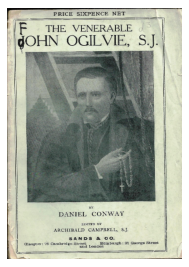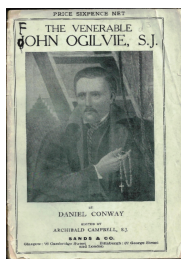
© Lorem ipsum dolor sit Nulla in mollit pariatur in, est ut dolor eu eiusmod lorem 2013
In the years after his death, Father John Ogilvie was revered as a martyr throughout Europe, wherever
his story was told. The Scripture scholar Cornelius a Lapide, who had known Ogilvie at Jesuit College,
wrote: "It is clear from the account of his martyrdom that he astonished the Calvinists, for although
unconquered by torture and still bold and ready in debate, he opened not his mouth against his
tormentors."
In a testimony in 1629 to Catholic Church authorities who were considering whether John Ogilvie had
died a martyr, William Sinclair, an Edinburgh lawyer who had been banished, wrote of what he had
heard from fellow prisoners and others who had witnessed the execution: “I know for certain that he
persevered in his Catholic faith up to the last moment of his life, in a devout, pious and steadfast
manner. On the night before his death, he devoted all the time that he
possibly could to prayer and spiritual meditation, and they further add that
he did the same before ascending the steps themselves, calling both God
and his fellow men to witness that he died in the Roman Catholic faith. His
piety and also his constancy were proved by his readiness to forgive all
those who had trespassed against him just as he prayed God to forgive
him, and by embracing and kissing the scaffold and finally bidding the
hangman to be of good heart and by pardoning him also. It is impossible
that he did not die as a martyr..........”
Following the Reformation, the Catholic Church had almost died out – but
it stayed alive in corners of Scotland, not least in parts of the North-East
and especially in John Ogilvie’s homeland of Banffshire. At Scalan, in
Glenlivet, a seminary operated from 1716-32, producing priests who
headed out to all parts of the country to minister in secret. These brave men were following in the
footsteps of the likes of Ogilvie. Scalan had been attacked and burned by government troops, but the
staff and students returned from hiding to rebuild and prepare to set out to keep our faith alive. In the
latter half of the 1700s, the Penal Laws were relaxed and in 1793 they were largely abolished, allowing
Catholics once again to practise their religion openly and free of fear.
St John Ogilvie
Path to Sainthood - Part One



© Lorem ipsum dolor sit Nulla in mollit pariatur in, est ut dolor
eu eiusmod lorem 2013
St John Ogilvie
Path to Sainthood
Part One
In the years after his death, Father John Ogilvie was revered
as a martyr throughout Europe, wherever his story was told.
The Scripture scholar Cornelius a Lapide, who had known
Ogilvie at Jesuit College, wrote: "It is clearfrom the account of
his martyrdom that he astonished the Calvinists, for
although unconquered by torture and still bold and ready in
debate, he opened not his mouth against his tormentors."
In a testimony in 1629 to Catholic Church authorities who
were considering whether John Ogilvie had died a martyr,
William Sinclair, an Edinburgh lawyer who had been
banished, wrote of what he had heard from fellow prisoners
and others who had witnessed the execution: “I know for
certain that he persevered in his Catholic faith up to the last
moment of his life, in a devout, pious and steadfast manner.
On the night before his death, he devoted all the time that he
possibly could to prayer and spiritual meditation, and they
further add that he did the same before ascending the steps
themselves, calling both God and his fellow men to witness
that he died in the Roman Catholic faith. His piety and also
his constancy were proved by his readiness to forgive all
those who had trespassed against him just as he prayed God
to forgive him, and by embracing and kissing the scaffold and
finally bidding the hangman to be of good heart and by
pardoning him also. It is impossible that he did not die as a
martyr..........”
Following the Reformation, the Catholic Church had almost
died out – but it stayed alive in corners of Scotland, not least
in parts of the North-east and especially in John Ogilvie’s
homeland of Banffshire. At Scalan, in Glenlivet, a seminary
operated from 1716-32, producing priests who headed out to
all parts of the country to minister in secret. These brave
men were following in the footsteps of the likes of Ogilvie.
Scalan had been attacked and burned by government troops,
but the staff and students returned from hiding to rebuild
and prepare to set out to keep our faith alive. In the latter
half of the 1700s, the Penal Laws were relaxed and in 1793
they were largely abolished, allowing Catholics once again to
practise their religion openly and free of fear.






















